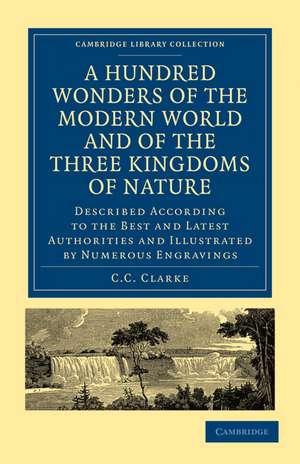A Hundred Wonders of the Modern World and of the Three Kingdoms of Nature: Described According to the Best and Latest Authorities and Illustrated by Numerous Engravings: Cambridge Library Collection - Education
Autor C. C. Clarkeen Limba Engleză Paperback – dec 2010
Din seria Cambridge Library Collection - Education
-
 Preț: 212.44 lei
Preț: 212.44 lei -
 Preț: 327.65 lei
Preț: 327.65 lei -
 Preț: 199.38 lei
Preț: 199.38 lei -
 Preț: 293.51 lei
Preț: 293.51 lei -
 Preț: 263.83 lei
Preț: 263.83 lei -
 Preț: 264.42 lei
Preț: 264.42 lei -
 Preț: 257.80 lei
Preț: 257.80 lei -
 Preț: 279.36 lei
Preț: 279.36 lei -
 Preț: 473.88 lei
Preț: 473.88 lei -
 Preț: 395.49 lei
Preț: 395.49 lei -
 Preț: 329.56 lei
Preț: 329.56 lei -
 Preț: 468.10 lei
Preț: 468.10 lei -
 Preț: 480.40 lei
Preț: 480.40 lei -
 Preț: 266.93 lei
Preț: 266.93 lei -
 Preț: 366.37 lei
Preț: 366.37 lei -
 Preț: 424.46 lei
Preț: 424.46 lei -
 Preț: 370.21 lei
Preț: 370.21 lei -
 Preț: 250.39 lei
Preț: 250.39 lei -
 Preț: 366.95 lei
Preț: 366.95 lei -
 Preț: 282.25 lei
Preț: 282.25 lei -
 Preț: 261.92 lei
Preț: 261.92 lei -
 Preț: 368.48 lei
Preț: 368.48 lei -
 Preț: 277.84 lei
Preț: 277.84 lei -
 Preț: 342.94 lei
Preț: 342.94 lei -
 Preț: 328.25 lei
Preț: 328.25 lei -
 Preț: 261.92 lei
Preț: 261.92 lei -
 Preț: 429.57 lei
Preț: 429.57 lei -
 Preț: 275.72 lei
Preț: 275.72 lei -
 Preț: 367.54 lei
Preț: 367.54 lei -
 Preț: 404.88 lei
Preț: 404.88 lei -
 Preț: 448.21 lei
Preț: 448.21 lei -
 Preț: 281.86 lei
Preț: 281.86 lei -
 Preț: 192.58 lei
Preț: 192.58 lei -
 Preț: 257.80 lei
Preț: 257.80 lei - 19%
 Preț: 457.64 lei
Preț: 457.64 lei -
 Preț: 324.68 lei
Preț: 324.68 lei -
 Preț: 367.92 lei
Preț: 367.92 lei -
 Preț: 321.14 lei
Preț: 321.14 lei -
 Preț: 428.70 lei
Preț: 428.70 lei -
 Preț: 292.82 lei
Preț: 292.82 lei -
 Preț: 423.54 lei
Preț: 423.54 lei -
 Preț: 242.14 lei
Preț: 242.14 lei -
 Preț: 279.20 lei
Preț: 279.20 lei -
 Preț: 421.58 lei
Preț: 421.58 lei
Preț: 478.87 lei
Preț vechi: 591.20 lei
-19% Nou
Puncte Express: 718
Preț estimativ în valută:
91.63€ • 97.99$ • 76.40£
91.63€ • 97.99$ • 76.40£
Carte tipărită la comandă
Livrare economică 18 aprilie-02 mai
Preluare comenzi: 021 569.72.76
Specificații
ISBN-13: 9781108017534
ISBN-10: 1108017533
Pagini: 816
Ilustrații: 40 b/w illus.
Dimensiuni: 140 x 216 x 41 mm
Greutate: 0.93 kg
Editura: Cambridge University Press
Colecția Cambridge University Press
Seria Cambridge Library Collection - Education
Locul publicării:Cambridge, United Kingdom
ISBN-10: 1108017533
Pagini: 816
Ilustrații: 40 b/w illus.
Dimensiuni: 140 x 216 x 41 mm
Greutate: 0.93 kg
Editura: Cambridge University Press
Colecția Cambridge University Press
Seria Cambridge Library Collection - Education
Locul publicării:Cambridge, United Kingdom
Cuprins
1. Mountains of the Andes, in South America; 2. Chimborazo; 3. Cotopaxi; 4. Pichincha; 5. Mount Etna, in the Island of Sicily; 6. Mount Vesuvius, near Naples; 7. Mount Hecla, in Iceland; 8. The Geysers; 9. Mont Blanc, in Switerland; 10. The Peak of Teneriffe; 11. The Souffriere Mountain, in the Island of St. Vincent; 12. The Peak of Derbyshire; 13. British mountains; 14. Stromboli; 15. The Himalaya Mountains, in the East Indies; 16. Sabrina Island, near St. Michael's, one of the Azores; 17. The Great Kentucky Cavern; 18. Grotto of Antiparos; 19. Grant Staffa Cavern, or Fingal's Cave; 20. The Yanar, or Perpetual Fire; 21. Herculaneum; 22. Pompeii; 23. The Great Earthquake of 1755; 24. The Giant's Causeway; 25. Natural bridges of Icononzo; 26. Rock bridge, in Virginia; 27. Bessely Gaut; 28. Extraneous fossils; 29. Subterraneous forests; 30. Coral reefs and islands; 31. Wide and inhospitable deserts; 32. Sands of the desert; 33. Diamond mines; 34. Gold and silver mines; 35. Quicksilver mines; 36. Ice islands; 37. Icebergs; 38. River of the Amazons; 39. The Apurimac; 40. The Oroonoko; 41. The Ganges; 42. The Indus; 43. The Nile; 44. Lake Superior; 45. Lake Huron; 46. Lake Asphaltites; 47. The Caspian Sea; 48. Falls of Niagara; 49. Falls of the Montmorenci; 50. Cataracts of the Nile; 51. Saint Winifred's Well; 52. Dropping well at Knaresborough; 53. Pitch lake of Trinidad; 54. Mud lake of Java; 55. Meteors; 56. Aerolites; 57. Spectre of the Broken; 58. The Miage; 59. Fata Morgana; 60. Remarkable thunderstorms; 61. Hail storms; 62. Hurricanes; 63. Monsoons; 64. Whirlwinds and waterspouts; 65. The great serpent, called the boa constrictor; 66. The sea serpent; 67. The elephant; 68. The orang outang; 69. The termintes; 70. The Banian tree; 71. The upas, or poison tree; 72. Pyramids of Egypt; 73. Cryptae, or catacombs of Alexandria; 74. Ruins of Palmyra and Balbec; 75. Ruins of Babylon; 76. Ruins of Persepolis; 77. Athens; 78. Temples of elephants; 79. Temples of Salsette; 80. Great Wall of China; 81. Porcelain Tower, at Nankin; 82. The Coliseum, at Rome; 83. Trajan's Palace; 84. The Pont du Gard; 85. St. Peter's, of Rome; 86. Eddystone light-house; 87. Bell Rock light-house; 88. Stonehenge; 89. St. Paul's Cathedral; 90. Westminster Abbey; 91. The Tower of London; 92. The Bank of England; 93. General Post-Office; 94. The Monument; 95. The Louvre; 96. The British Museum; 97. The Linwood Gallery, Leicester Square; 98. Bullock's Museum, Piccadilly; 99. Dr. Herschel's Grand Telescope; 100. The steam engine.
Descriere
Attributed to Sir Richard Phillips, this fascinating 1834 encyclopaedia contains articles on natural and man-made curiosities across the world.














